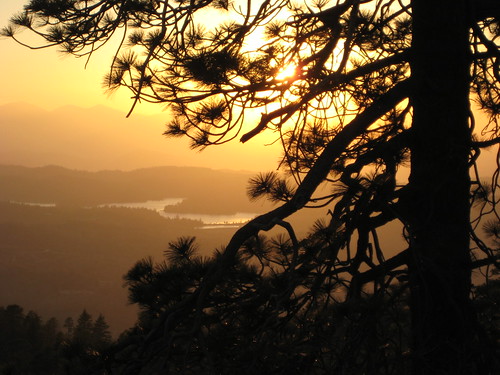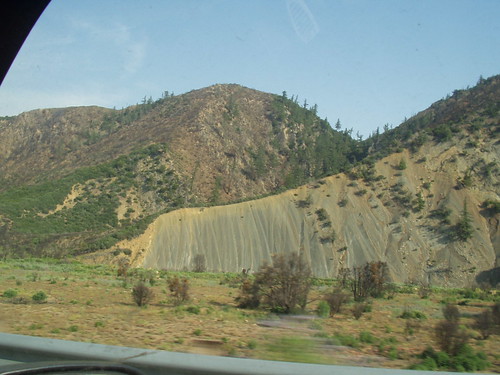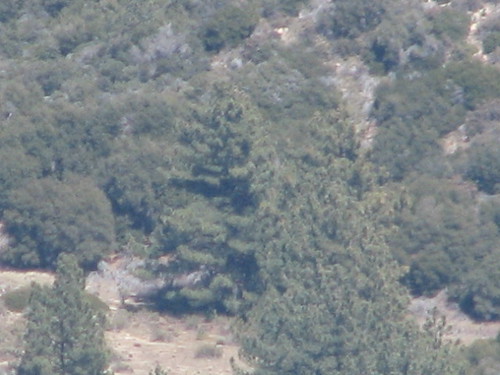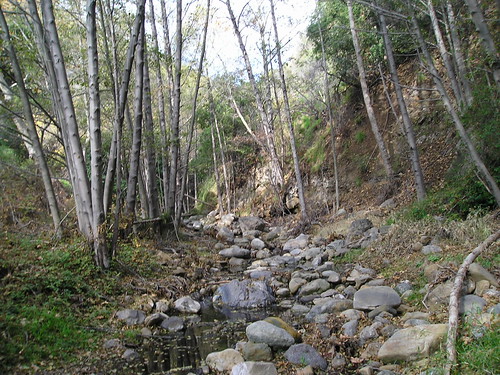There are plenty of places where trees just don't belong. Some places are too dry, too windy, or too wet. Perhaps fires or floods occur too often, or the soil is too thin or nutrient-poor. Trees are great, but they don't belong everywhere.

Above: smoke plume from a fire in the San Gabriel Mountains.
The San Gabriel Mountains of southern Californis are a place that doesn't support a lot of trees. Those trees that do naturally occur there are special - over vast stretches of time they have adapted to survive in a place with extended hot and dry summers punctuated by torrential winter downpours, and at high elevations, heavy snow and ice. In the fall, raging hot Santa Ana winds race through the canyons, spreading fires started by careless or malicious humans or by the dry lightning storms that sometimes form over the higher peaks. Before European colonization the Native Americans also often lit fires as part of their land management practices. The deep canyons that slice down the face of the mountains support cottonwoods, willows,and alders. The high, snowy peaks offer habitat for ponderosa, Jeffrey, sugar, and coulter pines as well as white fir and incense cedar. Mid- elevation steep slopes and gullies that face north support live oaks and bigcone Douglas-fir, which is a special species of Douglas-fir that tolerates fire and drought.

Above: a view of the San Gabriels in the distance, as seen from the San Bernardino Mountains. The latter range supports more pine forest than the former, but is still a rather dry ecosystem.
About 80 percent of the land of the San Gabriels don't support trees at all, but instead a diverse dense scrubland known as chaparral. This ecosystem is incredibly resilient to fire, Dought, and shallow soils. It also holds the slopes up. When it is temporarily knocked back by fire, any downpour or small earthquake sends mudslides or rockslides down the hills, though the surviving roots of many species still hold the soil. When chaparral is displaced by invasive species or removed, the mountains literally collapse. The San Gabriels are one of the youngest and fastest rising mountain ranges in the world - the San Andreas fault runs right along the northern slopes and with every earthquake the mountains rise a bit more.

Above: a hillside covered in a chaparral 'forest'. This hillside supports small ash and oak plants; both are descendants of larger trees and over tens of thousands of years have decreased in size to adapt to harsh, dry conditions.
A few years ago a huge fire ripped through the mountains, and killed a bunch of trees. This includes naturally occurring trees as well as some plantations that were planted years ago at lower elevations. The Forest Service got a grant from Mobil of all people to 'replant' the mountains. Planting trees is good, right? Well... the situation is complicated. Some believe that the fire was more intense than it would have naturally been, because of fire suppression or climate change. Perhaps the trees won't return on their own. Perhaps by planting the right type of tree, we can speed up the recovery process. Perhaps.

Above: black oak leaves sprout from the base of a tree killed by a very intense fire. California oaks, including chaparral scrub oaks, are amazingly resilient to fire.
We'll never know because the right trees weren't planted. Most of the little trees that were planted came from other mountain ranges, with different climates and soils. Some have claimed that trees were also planted too low in elevation, where it is too hot and dry. There was also an element of bad luck - it was a dry year. The result? Most of the trees have already died, and the long dry season is only starting. Maybe it's just as well. Coulter pines, which were planted in high densities, naturally occur in low densities, and the plantations from the 1960s that were hit by this fire burned furiously. I also noticed tree planting happening in the San Bernardino Mountains, where a fire almost destroyed our family cabin. This particular fire was unusually intense due to bark beetles having killed pine trees. The main reason this happened was the pine forest was TOO DENSE due to fire suppression. The fire burned through dead and dying overpopulated pine trees and while we were lucky, many others lost their cabins and homes. So why is it a good idea to REPLANT dense pine trees in this same area?

Above: a pine plantation (of introduced Canary Island pine) in the San Gabriel Mountains. Note that the chaparral has been cleared from around the trees, leaving a weedy mess. Note also the odd shape of the trees - this resulted in them burning despite 'fuel control'.
The most ridiculous thing about this whole fiasco? People were seriously promoting the idea that trees had to be planted because otherwise the chaparral would 'choke the trees'. Just a few paragraphs before was the assertion that the fire was so severe it killed all the plants including the seeds in the soil. If this were the case, where would chaparral even come from to 'choke' the trees? Furthermore, if chaparral were able to outcompete trees, why hasn't it already done so? It's had countless centuries of fires, drought, and floods to work with. If the chaparral choked any forest, it was probably 10,000 years ago when the wetter Ice Age climate was ending. Since then, it's simply surviving where the trees can't. Planting trees and 'weeding' away chaparral near them is not only putting the wrong kind of medicine on a burn wound - it's actually ripping off the band-aid as well.

Above: after a fire in the Los Padres National Forest, bigcone Douglas-fir still stands on the ridges, resprouting where foliage was singed; patchy chaparral recovers on the drier slopes. The 'badland' area in the center of the photo is naturally bare, but it's an example of how much erosion can happen in areas without chaparral.
Bigcone Douglas-fir, the only appropriate conifer to plant in the southern San Gabriel Mountains below 4000 feet, is an incredibly shade-tolerant species that actually grows THROUGH chaparral, after being sheltered from the hot sun by said shrubs. Coulter pine also often grows right up through dense chaparral. If anything, the trees eventually 'choke out' the chaparral, but if they are naturally regenerating trees, this is a natural process, not a bad thing. This is why on the wetter, moister north slopes where fires are less intense, you eventually end up with neat stands of bigcone Douglas-fir. I think there is a legitimate case to be made that bigcone Douglas-fir distribution is decreasing due to frequent fires, and it makes sense to plant a few seedlings grown from locally-collected seed. I don't think it would be a bad idea for people to crawl up under the chaparral and plant some bigcone Douglas-fir seedlings under its shade during a cool November day. Of course, that isn't what happened. Trees were planted in the open, and lovingly 'weeded' and 'loved to death'.

Above:Coulter pines in the San Gabriel Mountains living in 'peace' with chaparral. This is an extremely remote area - no one planted these native Coulter pines or 'protected' them as they grew. They simply thrived in the habitat they are adapted to live in.
The moral of this whole rant? Restoration and reforestation are great when applied with a realistic understanding of how the ecosystem you are trying to restore works. However, RE-forestation involves planting the type of trees that naturally occur in an area, using locally collected plant material. If you don't do that, you lose the 're'. If you plant trees in wild ecosystems out of their natural range, because you like trees, at best you are wasting time and money. At worst, you are performing an arrogant act of 'nature gardening' that will lead the area into worse fire danger in the following decades, reduce a diverse ecosystem to a monoculture, and/or release another invasive species. In many cases, chaparral is the natural vegetation in southern California, and if you don't like it for some reason, well, you can ask yourself if you dislike it more than having a flood or rockslide destroy your home. If you answer yes, you should probably move to a different state. Not Vermont though, please.

Above: this creek, in the Santa Monica Mountains, is lined by alder trees. Such trees also line many creeks in the San Gabriel Mountains. They are killed by fire and also often washed away by floods, but are very fast-growing and quickly recolonize impacted areas.

I actually even wrote a piece on this in my Timeless Environments blog after reading the Chaparral Institute blog on the subject.
ReplyDeletehttp://timeless-environments.blogspot.se/
Thanks for another great article on a subject that is close to me as I lived up in those mountains for more than 25 years, while San Jacinto Mtns. I love your pictures, even of the ones with the Canary Island Pines. I wrote a pice on them some time back as I live closer to the Canaries in my life now than ever before. I live in Sweden and we like going on holiday there in January/February.
It's a really kool place and one that I always wanted to see as I have worked with planting the pines and maintaining them in the landscape environment in cites. Same with the Date Palms from the Canaries. I always have a desire to see some plant I appreciate, read&study about and apply in the landscape in it's own native Habitat.
I actually bookmarked your website some time ago as the title intrigued me. I love Permiculture and Australia's own Natural Sequence Farming which in some ways is close to what Joel Salatin does.
But my interest in Slow Water Movement comes from my interest and involvement here with the work of long since past Viktor Schauberger and the theories on energy from water he wrote about as a Austrian Forester and self taught Physicist who thought outside the conventional box.
I'll be reading some more here.
Thanks, Kevin
This is excellent. I'll make sure this gets tagged on our blog at the Chaparral Institute.
ReplyDeleteThanks! By the way, for other readers, the Chaparral Instutite blog can be found at http://californiachaparral.org/wordpress1/ where there is another take on this issue. Timeless made a neat post about it too, see their blog linked above.
ReplyDeleteThanks Charlie! I'd been wondering about the post-fire tree planting going on up there. I am afraid people are operating with good intentions and muddy information about the mountain ecosystem.
ReplyDelete